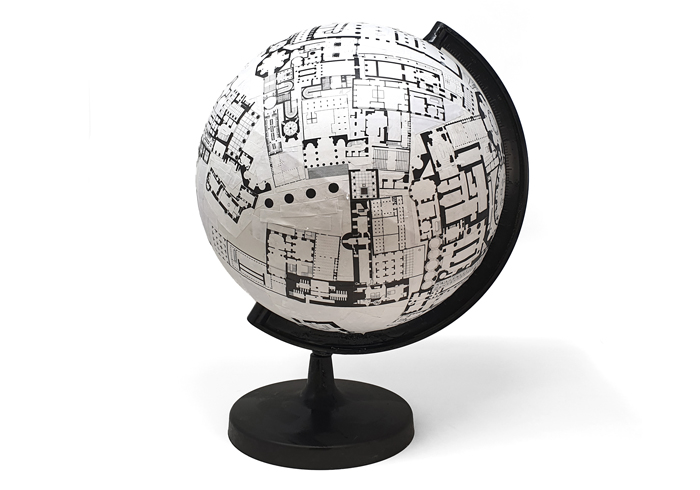An architect explores the landscape of his home
By Sam Jacob
Lockdown in London. Week 3. Being at home is starting to feel like the only reality we’ve known. All of us under our own roofs, only stepping anxiously into the outside world for the once-a-day, government-mandated exercise-hour. And when we are out, walking the almost empty city streets, we are hyperaware of distance: pandemic slaloming in loose loops around each other as we project and defend our expanded perimeters. The noun ‘distance’ – once seemingly static; an inert, straightforward relationship between A and B – has become a verb – an act of maintenance, endlessly recalculated.
The distinction between inside and out has never felt quite so extreme – even ordering a Domino’s pizza, once a symbol of the uninterrupted continuity of the modern world (a product of infrastructure and supply chains: from suppliers to restaurant to, seamlessly via bike, the living room), has become an alienating ritual performed at the front door. A product that’s really delivered to the door, rather than to a person. And in that sense, we’re developing new relationships to the inanimate. We’re voluntary prisoners of architecture – self-incarcerators within domesticity.
Switch on the TV and there’s no escape, only other homes, others isolated. Ant & Dec’s Saturday Night Takeaway – always the most up-to-date barometer of the now – is just a split screen with two guys on their sofas. Reporters report live from their attics, we get the news from a kitchen extension with bifolding patio doors. The world is being swallowed up into one nonstop domestic interior. And patio doors aside, there’s no visible exit strategy.
The more fixed and immobile we have become, the more the home seems to have become dislocated. Its normal relationship to the street, to the neighbourhood and to the city and world beyond has been distanced. As the outside world has shrunk, our interiors have necessarily become vast and Tardis-like, despite the fact that this might not be the case in actual spatial terms. The home is now also the school, the office, the pub, the gym. It’s not just what we’re doing there, it’s the feeling of space too. In our confinement our interior seems to have become a vast geography. The minutiae of quotidian routes – bedroom to bathroom, sofa to kitchen – have become the episodes of epic voyages. Each the subject of a cinematic dolly zoom.
This new world of interiors is unfolding as a landscape does once you’ve topped the brow of a hill: opening to the ocean’s horizon. Bedsheets like rolling hills, plant pots as forests, rugs like piazzas, furniture like buildings, a new Lilliputian urbanism. (Isn’t it weird that the thing we are afraid of in the vast outdoors is itself so tiny?)
And it’s not only space that’s changed. Time has warped too – speeding up and slowing down, drifting off, even – as its usual connection to space (the opening and closing times of bars and shops, for example) has loosened.
This new attention to domestic detail is part of the way we see each other now. Across Instagram we’re rearranging our bookshelves, scrubbing bathroom tiles, tending to seedlings, maintaining sourdoughs as if we’re suddenly looking at that old domestic world magnified.
Perhaps we are all now Jean Des Esseintes, the antihero of Joris-Karl Huysmans’s novel Against Nature (1884), perhaps the greatest account of the psychological freedoms and horrors of the domestic interior. Disgusted with the world, Des Esseintes retreats into his home where, chapter by chapter, his interiority inflates every aspect of domestic lifestyle. Eating, decorating, listening to music, reading: for each of these activities his separation from the world creates possibilities for refinement. And each refinement becomes, ouroboroslike, a further descent into isolated individuality. The home is figured on one hand as somewhere separate from society, on the other as a projection towards that same society. And more than anything, the home is presented as extension of the psychological interior. (We’ll leave the tortoises out of this for the moment.)
And as our own domestic interiors detach, the gravitational force that the outside world exerts on them weakens. The social codes of traditional home life are developing their own new logics, domesticity slipping into something less defined and more unknown, perhaps into something wilder. I mean, what even is a kitchen these days? Can anyone remember what a bedroom was supposed to be?
Meanwhile, what were once the furthest wilds on the planet have been transformed into landscapes of leisure, extraction and exploitation: from the heights of Everest, with its adventure-tourist queues, 4G and litter, to the depths of the Mariana Trench, full of cosmetics microbeads, what were once the extremities of the Earth have been drawn closer to our world.
So perhaps our current reality is the full realisation, the final flip, in the great reversal of human habit from an exterior – on the surface of a spherical planet floating in space – to an endless world of interiors.
Online exclusive published 14 April 2020
